Letters from Lodi
An insightful and objective look at viticulture and winemaking from the Lodi
Appellation and the growers and vintners behind these crafts. Told from the
perspective of multi-award winning wine journalist, Randy Caparoso.
Common misperceptions of Lodi Zinfandel and other errant information on Lodi found online
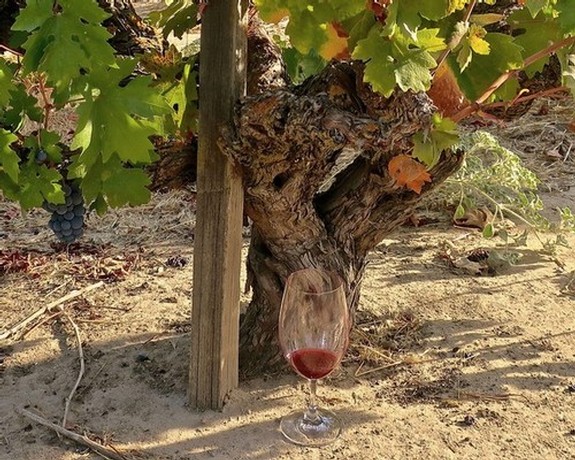
Ancient vine of Lodi Zinfandel (over 120 years old!) growing in the region's sandy alluvium and full-sun Mediterranean climate.
You should never believe everything you find online. That goes for just about everything, but especially for wine. There is so much misinformation about wine floating around the internet like garbage all across the world's oceans, I really don't where to begin.
But since this is a blog brought to you courtesy of Lodi winegrowers, let's just address some of the things you find about Lodi wines on, as many senior citizens like to call it, "the Google"—that wonderful, modern-day substitute for what we used to rely on for information, those quaint and nostalgic objects called "books."
I Googled "Lodi wine" just the other day and saw a list of questions conveniently parked at the top of the page, in a section called "People also ask."
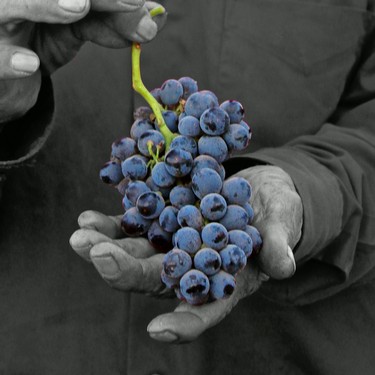
Zinfandel cluster from Lodi vines over 130 years old.
Talking about curiosity killing a cat, here is what I found...
Question #1: "What is Lodi wine?"
Google's answer: Lodi is best known for its full-bodied Old Vine Zinfandel wines [Google's bolding]. In addition to Zinfandel, Lodi leads all other California wine districts in the production of Cabernet Sauvignon, Merlot, Chardonnay, Sauvignon Blanc, and Viognier. Lodi has been a major winegrape growing region since the 1850s.
Correct answer: Yes, Lodi is best known for its old vine Zinfandel. We have more old vines as well as more Zinfandel growing in Lodi than any other region in California—well over 40% of the state's yearly production, to be more precise. The description "full-bodied," on the other hand, is very misleading. The inference, when wines are described as such, is that Lodi Zinfandels are fuller in the body than Zinfandels grown in other California wine regions. That couldn't be farther from the truth! Just about all California-grown Zinfandels—let's say, over 98%—are full-bodied, with alcohol levels somewhere between 14% and 15.5%. It is safe to say that a full body, primarily determined by the level of alcohol, is an industry-wide standard for Zinfandel as a varietal category. It is far from unique to Lodi, and very typical of commercial Zinfandels grown everywhere else in the state.
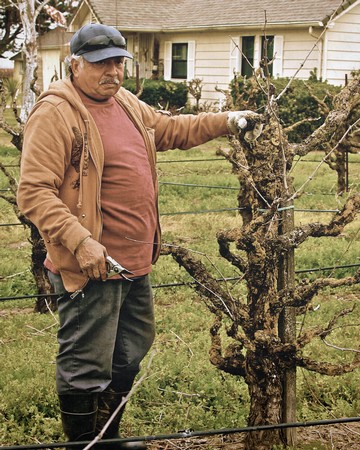
Winter pruning of old vine Lodi Zinfandel.
If anything, though, because Lodi has a more consistent Mediterranean climate distinguished by growing conditions influenced by more sunlight than in other regions—the coastal areas of California, on the other hand, typically see much more fog or cloud cover during growing season days—the fruit profile of Lodi Zinfandels tends to be characterized by two things:
1. Bright fruit qualities veering toward red berries (Napa and Sonoma Zinfandels, in comparison, are typified by red and blacker fruit qualities).
2. A softer tannin level resulting from lower tannin—the phenolic content derived from the skins, seeds, and stems of grapes—which is a reflection of the impact of the higher degree of sunlight on the skins and seeds of grapes grown in Lodi, compared to that of other California regions.
Because Lodi Zinfandels are lower in tannin, giving them a softer and rounder feel in comparison to Zinfandels from other wine regions, Zinfandels grown in Lodi actually come out tasting lighter than other Zinfandels, especially those from the vaunted Napa Valley and Sonoma County regions. In other words, if anything, Lodi Zinfandels are typically less "full-bodied" than other California Zinfandels, mostly because they have less tannin.
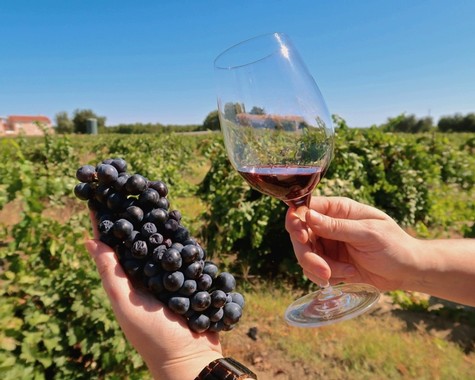
Tasting Lodi Zinfandel from the glass with a cluster from the old vine vineyard going into the wine.
In fact, a more accurate description of a Lodi Zinfandel (attention Google!) would be that "Lodi is best known for a kinder, gentler style of old vine Zinfandel." If, of course, this was what you'd actually find on Google, then curious consumers would at least be able to walk away with these two, simple bits of factual information:
1. If you want a lighter, softer, more fragrant style of Zinfandel, buy one from Lodi.
2. If you're looking for a stronger or fuller-bodied style of Zinfandel, look for one from another California region.
Google is obviously not about nuanced explications. The reality of fine wines is that it is nuanced. That's why we love it. Too bad the misleading information found online is no help.
Question #2: "What does Lodi wine taste like?"
Google's answer: The grape variety Lodi is known for most is Zinfandel, with its diverse array of flavors from berries to smoky tobacco [Google's bolding], giving the wine a unique taste, impossible to mix up with other wines. The Lodi grapes are juicy and sweet, that offer minimal color variation but have extremely delicious flavors.
Correct answer: Honestly, I don't know where, what or how these obviously algorithm-based answers are cooked up. But they're there, what can you say?
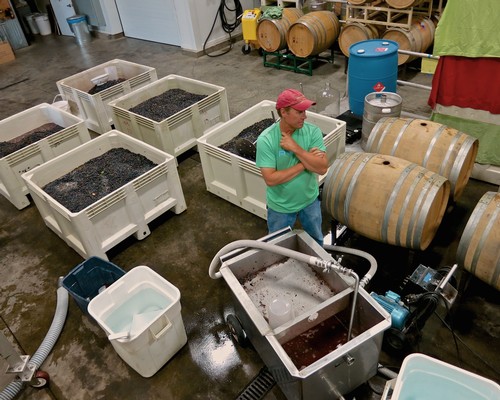
Fermenting macrobins of small-batch, handcraft Lodi Zinfandel.
The biggest and most obvious issue, of course, is the fact that Zinfandel is far from the only type of wine coming out of Lodi. Then again, all wine regions are pretty much saddled by the same kind of misleading information. When you Google "Sonoma wine," for instance, one of the first questions posed on the Google page is, "What wine is Sonoma County known for?"—Google's answer is "Sauvignon Blanc and Zinfandel." This would be big news to Sonoma County growers and vintners since they grow and produce far more Chardonnay and Pinot Noir than they do Sauvignon Blanc and Zinfandel. How screwed up is that?
But if Google wants to talk primarily about Zinfandel as being the essence of "Lodi wine," at least we can say that they get the first part of their answer right: Zinfandel tastes like "berries"—raspberry, blackberry, blueberry, and often cherry and strawberry. The only hitch is that all California Zinfandels demonstrate variations of these varietal characteristics in their aroma and flavor, not just those from Lodi.
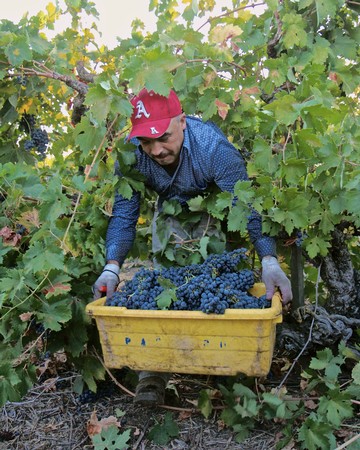
Harvesting of the Lodi Zinfandel vineyard was originally planted over 120 years ago.
The part where Google veers completely off-course, however, is in its bold-lettered suggestion that Lodi Zinfandels are characterized by "smoky tobacco." Let's make this perfectly clear: Wine grapes do not naturally have a taste of "smoky tobacco," they have fruit-related sensory attributes. Whenever you find "smoky tobacco" in a wine, this is a byproduct of a wine that has been aged in oak barrels. Barrels are manufactured by a process involving the bending of wet wood staves over an open fire, hence giving the insides of barrels a burnt char (or "toasted") attribute, which can indeed impart "smoky tobacco" flavors to any wine aged therein.
The point being, it is never correct to characterize Zinfandel itself as having a "smoky tobacco" taste because that is a taste profile resulting from barrel aging, not as a natural byproduct of a grape grown in any region. We are quibbling mostly because there are many kinds of wines that are aged in oak barrels, thus ending up with smoky qualities. Chardonnays and Cabernet Sauvignons, to cite just two examples, are the most popular varietal wines of today that are typically aged in barrels. Even if they're not actually aged in barrels, vintners typically stick charred pieces of wood into the vats of Chardonnay and Cabernet Sauvignon to add the smoky flavors, like you would a bag of tea into the hot water in your cup—most consumers don't care how those smoky flavors get there, they just want it, and expect it, in their wines.
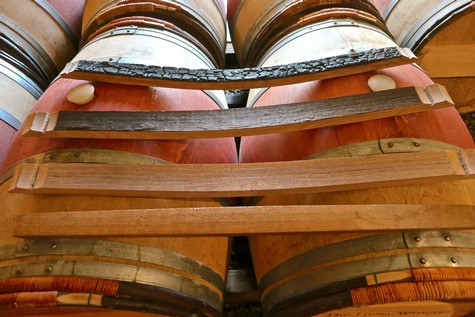
Demonstration of various "toast" levels on the insides of barrels—which impart "smoky" tastes in wines—on French oak at Lodi's The Lucas Winery, which specializes in old vine Zinfandel and Chardonnay utilizing these barrels.
While inaccurately citing "smoky tobacco" qualities as being part of a typicity specific to Lodi Zinfandel, Google exacerbates the issue further by stating that this is a "unique taste... impossible to mix with other wines." If that's the case, why do you find this exact same taste in gazillions of bottlings from other wine regions made from Chardonnay, Cabernet Sauvignon, Pinot Noir, Sauvignon Blanc, Syrah, Petite Sirah, and on and on? Why do you also find "smoky tobacco" tastes in, say, bourbon and scotch whiskeys? Answer: because these spirits are also typically aged in barrels, and they're not even wines! Simply put, there is nothing unique about finding smoky tastes in Zinfandels, let alone Zinfandels from Lodi.
If anything, Lodi Zinfandels tend to have less smoky qualities than Zinfandels from other California wine regions for the simple reason that Zinfandels grown under the full-blown sun of Lodi tend to be more fruit-focused; whereas the heavier, less overtly fruited and higher tannin Zinfandels from other regions (such as Napa Valley, Sonoma County, and even Amador County just a few miles east of Lodi) usually see more aggressive oak aging, and end up with even stronger "smoky" qualities.
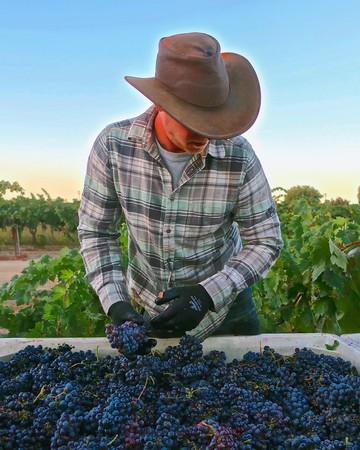
Zinfandel harvest in early 1900s vineyard on the east side of Lodi's Mokelumne River AVA.
Finally, there is a bone to be picked with the other part of answer #2, which states that "Lodi grapes are juicy and sweet, that offer minimal color variation but have extremely delicious flavors." Oh, for Pete's sake, all grapes are "juicy and sweet," whether they're grown in Lodi or Languedoc in France, New York or New Zealand, Chile or China, Tennessee or Timbuktu—sweetness is most certainly not a characteristic distinguishing grape grown in Lodi, nor any other region of the world.
Finally, there is the description, "extremely delicious flavors"—what does that even mean? Is Google suggesting that wines of other wine regions in the world are less "delicious" than Lodi's? Obviously, this pat and entirely meaningless answer simply reflects the quirkiness of online, computer-generated information; which goes back to our original point: Don't believe everything you read.
We may be making mountains out of molehills, but here is the basic issue: All kinds of people read this stuff—from curious, innocent novice wine consumers to experienced wine professionals cruising for information to help them with their research—and they all automatically believe it because it is far easier to accept what's at the top of a Google page than actually go through the trouble of finding out what's actually real.
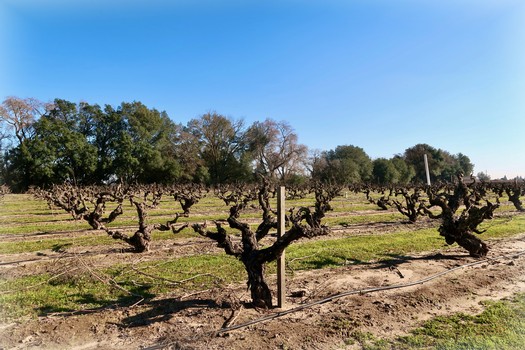
Recently pruned 1918 block of Lodi Zinfandel located along the Mokelumne River.
Question #3: "What does Lodi mean on a wine bottle?"
Google's answer: The Lodi Appellation is a federally designated American Viticulture Area recognized for the distinctive quality of its wines [Google's bolding].
Our answer: Finally! A short, sweet, accurate description of what "Lodi" on a wine label means. The difference here is that the use of "Lodi" on a wine label is strictly regulated. Therefore, in this case, Google can just stick to facts, without having to draw from the tons of misinformation—or the risk of misinterpreting information (easy to do when it comes to a convoluted subject such as wine)—floating around the internet order to formulate an answer.
Our advice on navigating the internet for information on Lodi wines and winegrowing: Stick to the information that we offer on Lodi Wine or (for more technical data) Lodi Growers. We live here, after all, and so at least we know what's really going on, as opposed to people who haven't spent a second here, in America's largest winegrowing region.
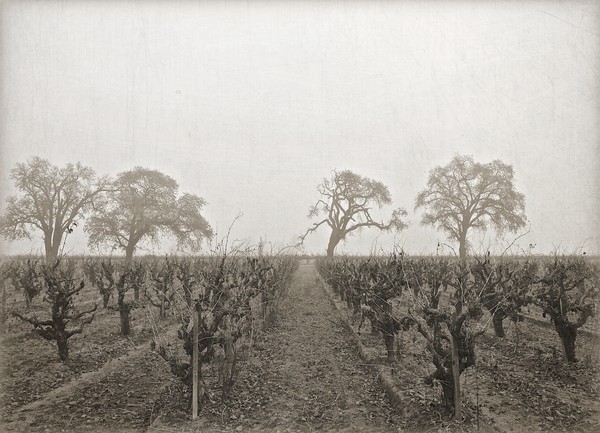
Wintering native valley oaks and old vine Zinfandel, which both thrive in the Mediterranean climate and extremely deep, fertile sandy loam soil of San Joaquin County's Mokelumne River-Lodi region.